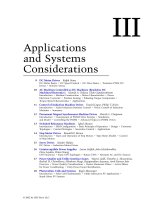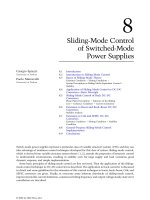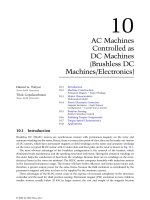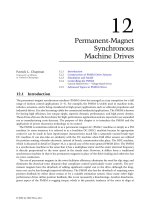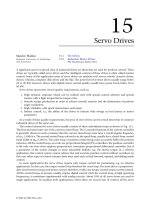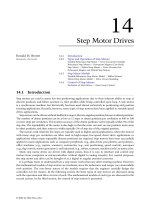Tài liệu Power Electronic Handbook P223 docx
Bạn đang xem bản rút gọn của tài liệu. Xem và tải ngay bản đầy đủ của tài liệu tại đây (344.33 KB, 24 trang )
© 2002 by CRC Press LLC
23
Computer Simulation
of Power Electronics
23.1 Introduction
23.2 Code Qualification and Model Validation
23.3 Basic Concepts—Simulation of a Buck Converter
23.4 Advanced Techniques—Simulation
of a Full-Bridge (H-Bridge) Converter
23.5 Conclusions
23.1 Introduction
This chapter discusses the possibilities and limitations of computer simulations for power electronics
systems. Obviously, advances in raw processing power for personal computers as well as the rapid devel-
opment of electronic design software have influenced the field of power electronics. In this context,
electronic design software means any software used for schematic capture, circuit board layout, electrical
or thermal simulation, documentation, and other applications. From the very beginning, schematic capture
and circuit board design software was used for power electronics systems. Of course, by their very nature,
schematic capture and layout programs had graphical user interfaces. However, long before the advent of
graphical user interfaces, electronic circuits were simulated by means of computers, mainly using variations
of the circuit simulation code SPICE.
SPICE, an abbreviation for
S
imulation
P
rogram with
I
ntegrated
C
ircuit
E
mphasis [14], was developed
in the 1970s at the University of California at Berkeley. The initial motivation for the creation of the
SPICE code was the simulation of analog electronic circuits to create integrated circuits (ICs). SPICE
solves the fundamental differential equations governing electric circuits containing basic
R
,
L
,
C
elements
and voltage (
V
) and current (
I
) sources, which can be fixed or dependent. Electronic parts, such as
diodes, transistors, etc., are either implemented as native elements with equations appropriate to their
nature or modeled via subcircuits containing basic and native electronic elements. Device equations are
typically based on semiconductor theory and refined using semiempirical parameters.
However, the use of SPICE or similar codes for the simulation of power electronics systems proved to
be difficult from the outset, because power electronics circuits typically operate in a highly discontinuous
mode, with power semiconductor devices acting as almost ideal switches. The simulators typically could
not follow the sudden switching transitions and would become unstable and crash. In addition, typically
only transient (time domain) analyses could be performed. If the transient analysis was at all stable, it
typically had to be run with very small time steps, resulting in long run times and huge output data files.
Other types of analyses, such as AC (frequency domain) analysis, were not possible. For AC analysis, the
circuit response is linearized around a bias point, and the small signal behavior is analyzed for a range
of frequencies. Typical results are the well-known Bode plots, which have proved to be very useful for
Michael Giesselmann
Texas Tech University
© 2002 by CRC Press LLC
the design of feedback control loops. Of course, if a normal power electronics system has several switches,
which constantly turn on and off, a single bias point cannot be found and AC analysis will fail. To make
matters worse, some circuit codes will perform AC analysis anyway and give totally erroneous results.
This chapter discusses techniques to overcome these problems. With these techniques, even complex
power electronics circuits can be simulated, their behavior can be studied in both the time and frequency
domain, and simulation can finally be fully integrated into the electronic design process.
In the following, the possibilities and limitations of simulation tools are discussed in more detail.
Computer simulation of electronic circuits in general and power electronics circuits in particular has
many obvious advantages, such as:
• New topologies can be quickly tested.
• New control strategies can be studied before implementation.
• Existing topologies can be analyzed for normal and fault conditions.
• Tests can be performed safely and quickly without risk of harm for personnel or equipment.
In addition, mechanical systems such as motors and mechanical attachments can be included in the
simulation of power electronics systems, thus enabling the simulation of complete mechatronics systems.
Before proceeding farther it should be acknowledged that some limitations remain, which can only
be overcome in special cases and with considerable effort involving extensive fine-tuning of models from
experimental data. These limitations involve the details of the switching transitions. These details include the
precise transients for voltages and currents in the switching devices, including peak voltage overshoot, etc.
To model these transitions precisely, which typically occur in the nanosecond time frame, not only exact
models for the semiconductors are necessary, but also the parasitic circuit elements, such as the inductance
of the device packages and the circuit connections, must be known and accounted for in the simulation
setup. Furthermore, the precise transient traces of the control signals in the nanosecond time regime
must be known and implemented.
For the above-mentioned reasons, the author does not recommend use of a simulation to verify that,
for example, a certain voltage stress level on an IGBT transistor in an inverter is not exceeded. Similarly,
the precise amount of switching (unlike conduction) losses is difficult to predict from a simulation. This
is better left to experimental work in the laboratory. However, with the exception of a very narrow time
window around individual switching transitions, the response of the circuit is very realistic. The reader
should recall that circuits are typically in transition for less than 1% of total time. Therefore, the voltage
and current levels in all inductors and capacitors are typically within less than 1% of the real values.
In conclusion, simulation is a great tool to study the behavior of new and existing circuits including
mechanical energy conversion devices and control systems with the possible exception of a very narrow
window around the switching transitions.
23.2 Code Qualification and Model Validation
Before software of any kind is used as part of a design process or in support of a comprehensive analysis
of an existing system, care should be taken to ensure that the software is working correctly for the intended
application. It should be pointed out that most software will work correctly for the purpose that it was
designed for, but sometimes software can easily be used (or misused) in ways or for applications for
which it was not intended. To make matters worse, the fact that some software should not be used for
a particular problem may not be so obvious to the user. The reader should be reminded that SPICE was
initially created to support the design of integrated circuits. Therefore, all basic elements are ideal and
zero dimensional, meaning that a resistor has no parasitic inductance associated with it and has no
propagation delay. Similarly, an inductor has no losses and no propagation delay nor any parasitic
capacitance. Nevertheless, SPICE turned out to be a code that could be used for general circuit analysis
and for many applications not imagined at the outset. However, every prudent engineer or engineering
supervisor should always try to evaluate a computer code using a typical example with known behavior
© 2002 by CRC Press LLC
and carefully compare the simulation results with the known (measured) facts about the circuit. In this
phase of code qualification, the engineer should also consult the accompanying documentation for back-
ground information about the code, its intended uses and limitations, and the internal workings of the
simulation engine. This may often give important hints to the fidelity of the results of a particular application.
Close attention should also be paid to the device models that may be contained inside a particular
code and their features and limitations. For example, it may be important to know if the model for a
transformer uses nonlinear magnetics or not. If the code (as PSpice® and many others) allows it, custom
models that have the properties needed for a given case can be added. However, in this case, the models
should be carefully tested and validated before they are used, especially if critical engineering decisions
are to be based on the results. The reader should also be cautioned that after an (ever more frequent)
upgrade of a particular code, it is advisable to at least perform some sort of check to determine that the
core of the simulation engine still behaves like before. For this purpose, the input files for a (not too
simple) benchmark case should be retained along with a documentation of the output from previous
versions of the code. It should also be mentioned that even “bug-fixes,” “Internet-patches,” or “code
maintenance” can potentially cause a simulator to behave differently. (All of those things have happened
to the author over the years). Sometimes the user may not even know that upgrades or the like have
taken place, if software maintenance is performed by the information technology (IT) department of a
company. In any event, it is always advisable to scrutinize the results of any simulation, compare them
against known facts and expectations, and resolve any discrepancies.
23.3 Basic Concepts—Simulation of a Buck Converter
In the following, the simulation of a buck (step-down) converter is described to illustrate the concepts
mentioned in the introduction. Good references for power electronics circuits in general are References
2, 6, and 9. The simulations have been performed using the SPICE implementation called PSpice, which
was developed by MicroSim Corp., and is currently sold by Cadence, Inc [8]. As far as possible, the
examples shown here can be run on the student version of the software. The examples are created using
the “Schematics” editor, which provides a convenient graphical user interface.
Figure 23.1 shows the well-known topology of a switch mode, step-down (also called buck) converter.
With the chosen values for the components, the converter is operating in the continuous-conduction
mode (as referred to the inductor current), and the output voltage is equal to the input voltage multiplied
by the duty cycle of the power MOSFET “M1.”
This circuit uses only standard elements from the library of the student version. (In a real circuit a
diode other than the 1N4002 would be used.) The key to a stable and quick simulation is the drive signal
for the power MOSFET. The hierarchical block called “PWM-Generator” accomplishes this task. The input
to this block is a voltage between 0 and 1 V, representing a duty cycle between 0 and 100%. The output
FIGURE 23.1
Schematic of a step-down converter.
0.5
+
-
20V
D1
D1N4002
D
Out+
Out-
M1
PWM_Generator
IRF 150
L1
Out_1
330uH
C1
2uF
Rload
15
V
I
© 2002 by CRC Press LLC
is a rectangular voltage, which is available between the outputs “Out
+
” and “Out
−
,” which has an
amplitude of 15 V, a duty cycle specified by the input and a repetition frequency, which can be freely
chosen. In addition, the switching transitions of this rectangular waveform have controllable slopes with
smooth edges to keep the simulator from crashing. Here is used a concept that was explained in the intro-
duction, stating that in the interest of stable operation, short run times, and manageable output file size,
it is not only permissible but recommended to replace the actual drive signal with one that is more
suitable for simulation. Careful examination of the drive signals shows only very minute differences as
the result of this substitution, but the advantages for stability and run times are enormous. Also as
mentioned in the introduction, the total time that the circuit remains in transitions is very small.
Therefore, the output voltage and the inductor current of this example are completely realistic.
For this example, the drive signals are generated entirely with so-called analog behavioral modeling
(ABM) components, which have no counterpart in the real circuit. In Section 23.4 a realistic model for
a real MOSFET driver circuit is presented, which also creates suitable gate drive signals.
Figure 23.2 shows the circuit that implements the PWM signals using the techniques discussed above.
This circuit is an implementation of the carrier-based PWM generation method with PSpice® ABM parts.
In the carrier-based PWM generation method, a voltage level, representing the duty cycle, is compared
with a triangular or sawtooth-shaped carrier. A convenient way to generate such a carrier without resorting
to mathematical functions with piecewise definition is to calculate the argument of a periodic trigono-
metric function. This is illustrated in Fig. 23.3. This figure was created using the MathCAD® [4] software
package. The circuit in the upper half of Fig. 23.4 shows the implementation of a sawtooth function using
basic ABM parts in PSpice in more detail.
In the lower part of Fig. 23.4, a more-compressed form with only one ABM part is shown, which generates
the same output. Using the compressed form not only results in space savings on the “Schematics”
page, but also reduces the total device count for the simulation. This can easily make the difference
between being able to run a circuit within the limitations of the student version or not. The circuit shown
in Fig. 23.2 compares the sawtooth signal with the duty cycle and amplifies the difference by a factor of
1000 (1 k) using a “Gain” device. The amplification factor controls the steepness of the transitions in the
PWM signal. A soft limiter on the output of the amplifier limits the signal amplitude to the range of 0
to 15 V.
The soft limiter uses a hyperbolic tangent function to achieve its function. To illustrate this, Fig. 23.5
shows a MathCAD [4] plot of a hyperbolic tangent function for different steepness factors
k
. In fact, the
steepness factors are just multipliers for the argument of the function. From Fig. 23.5 it is easy to see
how a transition can be achieved that is steep but has rounded corners without abrupt slope changes at
the same time. These signal properties are the key to a fast and stable operation of the simulator. The
last element in Fig. 23.2, named “E1,” is a voltage-controlled voltage source. It takes the output of the soft
limiter, which is a voltage with respect to ground, and creates a voltage with a floating reference potential
for driving high-side MOSFETs such as in buck converters.
FIGURE 23.2
Schematic representing the “PWM Generator” hierarchical block of Fig. 23.1.
Out+
Out-
(1/@Pi)
∗
Atan(Tan
(@Pi
∗
@Freq
∗
TIME +@Pi/2))
+0.5
Pi = 3.14159265
Freq = 150kHz
Duty_Cycle
1k
E1
GAIN = 1
15
1.0
0
+
+
-
+
-
-
D
© 2002 by CRC Press LLC
Figure 23.6 shows the simulation results for the buck converter shown in Fig. 23.1. The simulation
shows a start-up event, where a gate signal with a duty cycle of 50% is suddenly applied to MOSFET
“M1” while both the inductor current as well as voltage on the output capacitor are zero. The upper half
of Fig. 23.6 shows the trace of the output voltage, whereas the lower half of the graph shows the inductor
current. It can be seen that both the output voltage (10 V) and the average output current (10 V/15
Ω
)
are represented correctly in Fig. 23.6. Since the input voltage is twice as high as the output voltage and
the losses (occurring only in the MOSFET and the diode) are minimal, the average input current is half
the output current. Because of the chosen gate signal generation, the simulation runs stable and fast,
especially if the high switching frequency of 150 kHz is considered, which was chosen for this example.
Considering the fact that for the buck converter the ratio of the input and output voltages is propor-
tional to the duty cycle
D
and the ratio of the average input and output currents is inversely proportional
to
D
, the buck converter is acting as a transformer for DC. As in an AC transformer, the product of
output voltage and the average output current is nearly identical to the product of the input voltage and
the average input current. Of course, if no losses were present, the products would be precisely identical.
FIGURE 23.3
Illustration of the mathematical functions used for carrier wave generation.
Generation of PWM Carrier Waves:
0.5
0
-0.5
0.5
0
-0.5
1
0.5
0
0 50 100 150 200 250 300
0 50 100 150 200 250 300
0 50 100 150 200 250 300
t⋅µs
-1
µs ϵ 10
-6
⋅sec ms ϵ 10
-3
⋅sec Freq := 10⋅kHz t : = 0⋅µs, 0.1⋅µs .. 300⋅µs
t⋅µs
-1
t⋅µs
-1
atan(tan(π⋅Freq⋅t))
π
asin(sin(2⋅π⋅Freq⋅t))
π
acos(cos(2⋅π⋅Freq⋅t))
π
© 2002 by CRC Press LLC
This is true for both the continuous, as well as the discontinuous-conduction mode (referring to the
current in the inductor), but in the latter case the dependence of the voltage and current ratio on the
duty cycle
D
would be more complicated.
This behavior can be modeled in such a way that the switching elements in the circuit are replaced by
an analog element, which is controlled by the duty cycle
D
. This element would create the same average
voltages and currents that are present in the real circuit. However, since no actual switching takes place,
the time step for the simulator can be increased dramatically, and the simulation could potentially run
faster by a factor of 100 or more depending on the switching frequency of the original circuit. The reason
is that, for a simulation of a circuit with switching elements, the time step (or, better, the time step ceiling,
since the time step is adjusted dynamically in many simulators such as PSpice) must be small enough to
ensure that the simulation can accurately follow the individual switching events. If the time step ceiling
is too big, the simulator will try to finish the simulation run as fast as possible and internally select a
time step that is just small enough so that the simulator remains stable. Remaining stable, however, does
FIGURE 23.4
PSpice implementation of the sawtooth function.
FIGURE 23.5
Hyperbolic tangent function with different steepness factors
k
.
@Pi
∗
@Freq
∗
TIME +@Pi/2
(1/@Pi)
∗
Atan(Tan
(@Pi
∗
@Freq
∗
TIME +@Pi/2))
+0.5
Pi = 3.14159265
Freq = 10 kHz
Pi = 3.14159265
Freq = 10kHz
TA N ATAN
{1/@Pi}
R1
Out
1k
Pi = 3.14159265
1
R2
Alt_Out
1k
+
0.5
23
V V V V
V
x := -2, -1.999..2 k := 1.. 10
1
0
-1
-2 -1 0 1 2
x
tanh(k⋅x)
© 2002 by CRC Press LLC
not mean that the results are accurate. The size of the next time step is always predicted from the slope
of the waveform just prior to the current time. If a step ceiling is set and the time step, which the simulator
would choose by itself, is bigger than the time step ceiling, the time step ceiling is used instead. The
choice of the proper time step ceiling requires some experience and experimentation. Figure 23.7 shows
an example of a simulation that was run with a time step that is too large. It was obtained by rerunning
the circuit shown in Fig. 23.1 with a different time step setting. Therefore, Fig. 23.7 can be directly
compared with Fig. 23.6. It is obvious that the waveform for the inductor current in Fig. 23.7 is irregular
and exhibits oscillations after the initial transient (after about 200
µ
s). These oscillations are caused by
integration errors due to the wrong time step settings. Obviously in this example there is no reason for
FIGURE 23.6
Simulation results for the buck converter shown in Fig. 23.1.
FIGURE 23.7
Incorrect simulation results for the buck converter due to improper time step settings.
20V
0V
1.5A
V (Out_1)
I (L1)
Output Voltage
Inductor Current
SEL>>
0A
0s 100us 200us 300us 400us
500us
Time
.
.
.
.
.
.
.
.
.
.
.
.
.
.
.
.
.
.
.
.
.
.
.
.
20V
0V
1.5A
V (Out_1)
I (L1)
Output Voltage
Inductor Current
SELϾϾ
0A
0s 100us 200us 300us 400us
500us
Time
.
.
.
.
.
.
.
.
.
.
.
.
.
.
.
.
.
.
.
.
.
.
.
.
© 2002 by CRC Press LLC
any oscillation after the initial transient, since the circuit is run with a constant duty cycle. However, if
an external feedback control system for the output voltage is present, such oscillations could occur as a
result of the control action of the system, which constantly changes the duty cycle to keep the output
voltage at a given value. In a case like this, considerable experience and good engineering judgment are
required to avoid the wrong interpretation of the simulation results.
As mentioned above, the use of a simulation model with an analog switch replacement could be advan-
tageous in such a case [1]. An example is shown in Fig. 23.8. A comparison with Fig. 23.1 shows that the
power MOSFET “M1” has been replaced by a hierarchical block called “Avg
_
PWM.” The associated sub-
circuit is shown in Fig. 23.9.
This subcircuit takes the voltage between the terminals “In” and “Diode” measured by the device “E2”
and scales it with the duty cycle
D
. The output is provided between the terminals “Out” and “Diode.” It
should be noted that the “Diode” terminal is virtually at ground potential (about 0.7 V below due to the
forward voltage of the diode) and the diode is not really needed for the operation of the circuit shown
in Fig. 23.8.
The device “H1” measures the output current coming from the terminal “Out” and scales the value
with the duty cycle
D
. The device “G1” will pull the scaled output current from the “In” terminal. This
will implement the DC-transformer equations mentioned above. Figure 23.10 shows a comparison of
the simulation output of the circuits shown in Figs. 23.1 and 23.8. It can be seen clearly, that the output
of the circuit with the average PWM switch represents the “instantaneous average” (short-term average,
taken over one switching cycle). In fact, if the switching frequency of the converter from Fig. 23.1 were
raised high enough, the traces for both converters would be identical. This is already evident if the traces
for the output voltage in Fig. 23.10 are compared since the output voltage of the switching converter has
very little ripple at the chosen switching frequency of 150 kHz. Mohan [7] extends the DC-transformer
approach for time-averaged modeling of H-bridge converters for motor drives.
FIGURE 23.8
Buck converter with time-averaged PWM switch.
FIGURE 23.9
Subcircuit for “Avg_PWM” block.
V_dc2
20V
+
-
0.5
D2
D1N4002
D Out
Diode
In
Avg_PWM
Rload2
Out_2
15
2uF
C2
330uH
L2
V
I
+
-
+
-
+
-
I(In) = I(Out)
∗
D
In
Diode
D
Duty_Cycle
GAIN = 1 GAIN = 1 GAIN = 1
H1
GAIN = 1
G1
E2 E1
-
+
-
+
-
+
Output_Current
V(Out,Diode) = V(In, Diode)
∗
D
Out
© 2002 by CRC Press LLC
Besides the obvious benefit of faster simulation times, the added benefit of the buck converter with
the average PWM switch is that AC or frequency domain analysis can be performed. A simulation setup
for this is shown in Fig. 23.11. Here the buck converter is fed with a 50% duty cycle bias with a 10% (100 mV)
AC component on top of it. The frequency of the AC component is swept from 100 mHz to 100 kHz
for five different load resistors, 5W, 10W, 20W, 30W, and 40W. The result is shown in Fig. 23.12. In the
upper portion of the diagram, the AC response of the output voltage is 2 V up to about 1 kHz (10% of
20 V input due to 10% AC amplitude). Above 1 kHz, the resonant peak of the LC-output filter is clearly
visible for the 30-
Ω
load, which represents the smallest damping. Ref. 1 shows how the subcircuit in
Fig. 23.9 can be used for other basic converters as well.
To model a more complex circuit, such as an H-bridge with a DC motor connected to it, in the
frequency domain, each half bridge can be modeled as a DC-transformer with a transformation ratio
that is controlled by the duty cycle as described in Ref. 7. As an alternative, the complete H-bridge could
be modeled as a linear gain-block with the duty cycle the input and the output voltage of the H-bridge
the output. This is realistic for the design of feedback control systems. In fact, H-bridge inverters for
FIGURE 23.10
Combined simulation results for the buck converters from Figs. 23.1 and 23.8.
FIGURE 23.11
Simulation circuit for performing AC analysis for the buck converters from Fig. 23.8.
20V
0V
1.5A
V (Out_1)
I (L1)
Output Voltage
Inductor Current
SEL>>
0A
0s 100us 200us 300us 400us
500us
Time
I (L2)
V (Out_2)
V_dc
20V
Vac
D1
+
+
-
-
D Out
Diode
In
Avg_PWM
ACMAG = 100 mV
DC = 0.5V
R_load
{R_load}
Out
2uF
C
330uH
L
Note: If Diode is used, DC bias for Duty Cycle is required:
PARAMETERS:
R_Load 15
V
I

